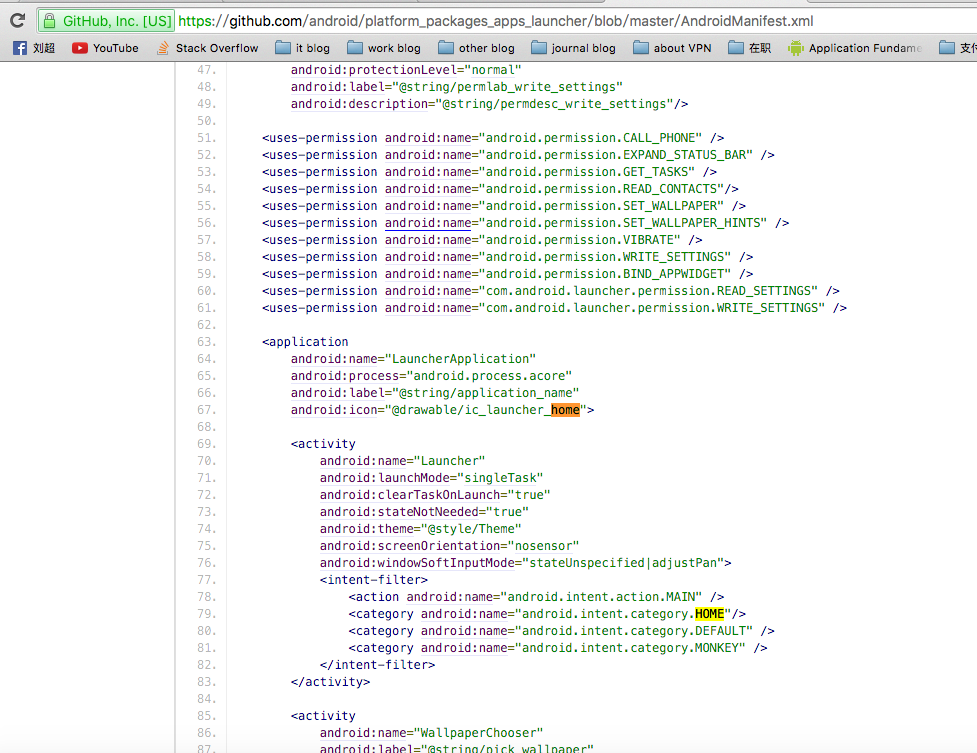Launcher程序就是我们平时看到的桌面程序,它其实也是一个android应用程序,只不过这个应用程序是系统默认第一个启动的应用程序,这里我们就简单的分析一下Launcher应用的启动流程。
不同的手机厂商定制android操作系统的时候都会更改Launcher的源代码,我们这里以android23的源码为例大致的分析一下Launcher的启动流程。
通过上一篇文章,我们知道SystemServer进程主要用于启动系统的各种服务,二者其中就包含了负责启动Launcher的服务,LauncherAppService。具体关于SystenServer的启动流程可以参见: android源码解析之(九)-->SystemServer进程启动流程
在SystemServer进程的启动过程中会调用其main静态方法,开始执行整个SystemServer的启动流程,在其中通过调用三个内部方法分别启动boot service、core service和other service。在调用startOtherService方法中就会通过调用mActivityManagerService.systemReady()方法,那么我们看一下其具体实现:
// We now tell the activity manager it is okay to run third party
// code. It will call back into us once it has gotten to the state
// where third party code can really run (but before it has actually
// started launching the initial applications), for us to complete our
// initialization.
mActivityManagerService.systemReady(new Runnable() {
@Override
public void run() {
Slog.i(TAG, "Making services ready");
mSystemServiceManager.startBootPhase(
SystemService.PHASE_ACTIVITY_MANAGER_READY);
try {
mActivityManagerService.startObservingNativeCrashes();
} catch (Throwable e) {
reportWtf("observing native crashes", e);
}
Slog.i(TAG, "WebViewFactory preparation");
WebViewFactory.prepareWebViewInSystemServer();
try {
startSystemUi(context);
} catch (Throwable e) {
reportWtf("starting System UI", e);
}
try {
if (networkScoreF != null) networkScoreF.systemReady();
} catch (Throwable e) {
reportWtf("making Network Score Service ready", e);
}
try {
if (networkManagementF != null) networkManagementF.systemReady();
} catch (Throwable e) {
reportWtf("making Network Managment Service ready", e);
}
try {
if (networkStatsF != null) networkStatsF.systemReady();
} catch (Throwable e) {
reportWtf("making Network Stats Service ready", e);
}
try {
if (networkPolicyF != null) networkPolicyF.systemReady();
} catch (Throwable e) {
reportWtf("making Network Policy Service ready", e);
}
try {
if (connectivityF != null) connectivityF.systemReady();
} catch (Throwable e) {
reportWtf("making Connectivity Service ready", e);
}
try {
if (audioServiceF != null) audioServiceF.systemReady();
} catch (Throwable e) {
reportWtf("Notifying AudioService running", e);
}
Watchdog.getInstance().start();
// It is now okay to let the various system services start their
// third party code...
mSystemServiceManager.startBootPhase(
SystemService.PHASE_THIRD_PARTY_APPS_CAN_START);
try {
if (wallpaperF != null) wallpaperF.systemRunning();
} catch (Throwable e) {
reportWtf("Notifying WallpaperService running", e);
}
try {
if (immF != null) immF.systemRunning(statusBarF);
} catch (Throwable e) {
reportWtf("Notifying InputMethodService running", e);
}
try {
if (locationF != null) locationF.systemRunning();
} catch (Throwable e) {
reportWtf("Notifying Location Service running", e);
}
try {
if (countryDetectorF != null) countryDetectorF.systemRunning();
} catch (Throwable e) {
reportWtf("Notifying CountryDetectorService running", e);
}
try {
if (networkTimeUpdaterF != null) networkTimeUpdaterF.systemRunning();
} catch (Throwable e) {
reportWtf("Notifying NetworkTimeService running", e);
}
try {
if (commonTimeMgmtServiceF != null) {
commonTimeMgmtServiceF.systemRunning();
}
} catch (Throwable e) {
reportWtf("Notifying CommonTimeManagementService running", e);
}
try {
if (textServiceManagerServiceF != null)
textServiceManagerServiceF.systemRunning();
} catch (Throwable e) {
reportWtf("Notifying TextServicesManagerService running", e);
}
try {
if (atlasF != null) atlasF.systemRunning();
} catch (Throwable e) {
reportWtf("Notifying AssetAtlasService running", e);
}
try {
// TODO(BT) Pass parameter to input manager
if (inputManagerF != null) inputManagerF.systemRunning();
} catch (Throwable e) {
reportWtf("Notifying InputManagerService running", e);
}
try {
if (telephonyRegistryF != null) telephonyRegistryF.systemRunning();
} catch (Throwable e) {
reportWtf("Notifying TelephonyRegistry running", e);
}
try {
if (mediaRouterF != null) mediaRouterF.systemRunning();
} catch (Throwable e) {
reportWtf("Notifying MediaRouterService running", e);
}
try {
if (mmsServiceF != null) mmsServiceF.systemRunning();
} catch (Throwable e) {
reportWtf("Notifying MmsService running", e);
}
}
});可以发现这个方法传递了一个Runnable参数,里面执行了各种其他服务的systemReady方法,这里不是我们关注的重点,我们看一下在ActivityManagerService中systemReady方法的具体实现,方法体比较长,我就不在这里贴出代码了,主要的逻辑就是做一些ActivityManagerService的ready操作
public void systemReady(final Runnable goingCallback) {
...
// Start up initial activity.
mBooting = true;
startHomeActivityLocked(mCurrentUserId, "systemReady");
...
}重点是在这个方法体中调用了startHomeActivityLocked方法,看其名字就是说开始执行启动homeActivity的操作,好了,既然如此,我们再看一下startHomeActivityLocked的具体实现:
boolean startHomeActivityLocked(int userId, String reason) {
if (mFactoryTest == FactoryTest.FACTORY_TEST_LOW_LEVEL
&& mTopAction == null) {
// We are running in factory test mode, but unable to find
// the factory test app, so just sit around displaying the
// error message and don't try to start anything.
return false;
}
Intent intent = getHomeIntent();
ActivityInfo aInfo =
resolveActivityInfo(intent, STOCK_PM_FLAGS, userId);
if (aInfo != null) {
intent.setComponent(new ComponentName(
aInfo.applicationInfo.packageName, aInfo.name));
// Don't do this if the home app is currently being
// instrumented.
aInfo = new ActivityInfo(aInfo);
aInfo.applicationInfo = getAppInfoForUser(aInfo.applicationInfo, userId);
ProcessRecord app = getProcessRecordLocked(aInfo.processName,
aInfo.applicationInfo.uid, true);
if (app == null || app.instrumentationClass == null) {
intent.setFlags(intent.getFlags() | Intent.FLAG_ACTIVITY_NEW_TASK);
mStackSupervisor.startHomeActivity(intent, aInfo, reason);
}
}
return true;
}首先是调用getHomeIntent()方法,看一下getHomeIntent是如何实现构造Intent对象的:
Intent getHomeIntent() {
Intent intent = new Intent(mTopAction, mTopData != null ? Uri.parse(mTopData) : null);
intent.setComponent(mTopComponent);
if (mFactoryTest != FactoryTest.FACTORY_TEST_LOW_LEVEL) {
intent.addCategory(Intent.CATEGORY_HOME);
}
return intent;
}可以发现,启动Launcher的Intent对象中添加了Intent.CATEGORY_HOME常量,这个其实是一个launcher的标志,一般系统的启动页面Activity都会在androidmanifest.xml中配置这个标志。比如我们在github中的android launcher源码中查看其androidmanifest.xml文件:

继续回到我们的startHomeActivityLocked方法,我们发现经过一系列的判断逻辑之后最后调用了mStackSupervisor.startHomeActivity方法,然后我们可以查看一下该方法的具体实现逻辑:
void startHomeActivity(Intent intent, ActivityInfo aInfo, String reason) {
moveHomeStackTaskToTop(HOME_ACTIVITY_TYPE, reason);
startActivityLocked(null /* caller */, intent, null /* resolvedType */, aInfo,
null /* voiceSession */, null /* voiceInteractor */, null /* resultTo */,
null /* resultWho */, 0 /* requestCode */, 0 /* callingPid */, 0 /* callingUid */,
null /* callingPackage */, 0 /* realCallingPid */, 0 /* realCallingUid */,
0 /* startFlags */, null /* options */, false /* ignoreTargetSecurity */,
false /* componentSpecified */,
null /* outActivity */, null /* container */, null /* inTask */);
if (inResumeTopActivity) {
// If we are in resume section already, home activity will be initialized, but not
// resumed (to avoid recursive resume) and will stay that way until something pokes it
// again. We need to schedule another resume.
scheduleResumeTopActivities();
}
}发现其调用的是scheduleResumeTopActivities()方法,这个方法其实是关于Activity的启动流程的逻辑了,这里我们不在详细的说明,关于Activity的启动流程我们在下面的文章中会介绍。
因为我们的Launcher启动的Intent是一个隐士的Intent,所以我们会启动在androidmanifest.xml中配置了相同catogory的activity,android M中配置的这个catogory就是LauncherActivity。
LauncherActivity继承与ListActivity,我们看一下其Layout布局文件:
<FrameLayout xmlns:android="http://schemas.android.com/apk/res/android"
android:layout_width="match_parent"
android:layout_height="match_parent"
>
<ListView
android:id="@android:id/list"
android:layout_width="match_parent"
android:layout_height="match_parent"
/>
<TextView
android:id="@android:id/empty"
android:layout_width="match_parent"
android:layout_height="match_parent"
android:gravity="center"
android:text="@string/activity_list_empty"
android:visibility="gone"
android:textAppearance="?android:attr/textAppearanceMedium"
/>
</FrameLayout>可以看到我们现实的桌面其实就是一个ListView控件,然后看一下其onCreate方法:
@Override
protected void onCreate(Bundle icicle) {
super.onCreate(icicle);
mPackageManager = getPackageManager();
if (!mPackageManager.hasSystemFeature(PackageManager.FEATURE_WATCH)) {
requestWindowFeature(Window.FEATURE_INDETERMINATE_PROGRESS);
setProgressBarIndeterminateVisibility(true);
}
onSetContentView();
mIconResizer = new IconResizer();
mIntent = new Intent(getTargetIntent());
mIntent.setComponent(null);
mAdapter = new ActivityAdapter(mIconResizer);
setListAdapter(mAdapter);
getListView().setTextFilterEnabled(true);
updateAlertTitle();
updateButtonText();
if (!mPackageManager.hasSystemFeature(PackageManager.FEATURE_WATCH)) {
setProgressBarIndeterminateVisibility(false);
}
}可以看到在LauncherActivity的onCreate方法中初始化了一个PackageManager,其主要作用就是从中查询出系统所有已经安装的应用列表,应用包名,应用图标等信息。然后将这些信息注入到Adapter中,这样就可以将系统应用图标和名称显示出来了。 在系统的回调方法onListItemClick中
@Override
protected void onListItemClick(ListView l, View v, int position, long id) {
Intent intent = intentForPosition(position);
startActivity(intent);
}这也就是为什么我们点击了某一个应用图标之后可以启动某一项应用的原因了,我们看一下这里的intentForPosition是如何实现的。
protected Intent intentForPosition(int position) {
ActivityAdapter adapter = (ActivityAdapter) mAdapter;
return adapter.intentForPosition(position);
}这里又调用了adapter的intentForPosition方法:
public Intent intentForPosition(int position) {
if (mActivitiesList == null) {
return null;
}
Intent intent = new Intent(mIntent);
ListItem item = mActivitiesList.get(position);
intent.setClassName(item.packageName, item.className);
if (item.extras != null) {
intent.putExtras(item.extras);
}
return intent;
}可以看到由于adapter的每一项中都保存了应用的包名可启动Activity名称,所以这里在初始化Intent的时候,直接将这些信息注入到Intent中,然后调用startActivity,就将这些应用启动了(关于startActivity是如何启动的下面的文章中我将介绍)。
总结:
Launcher的启动流程
Zygote进程 --> SystemServer进程 --> startOtherService方法 --> ActivityManagerService的systemReady方法 --> startHomeActivityLocked方法 --> ActivityStackSupervisor的startHomeActivity方法 --> 执行Activity的启动逻辑,执行scheduleResumeTopActivities()方法。。。。
因为是隐士的启动Activity,所以启动的Activity就是在AndroidManifest.xml中配置catogery的值为:
public static final String CATEGORY_HOME = "android.intent.category.HOME";可以发现android M中在androidManifest.xml中配置了这个catogory的activity是LauncherActivity,所以我们就可以将这个Launcher启动起来了
京东创始人刘强东和其妻子章泽天最近成为了互联网舆论关注的焦点。有关他们“移民美国”和在美国购买豪宅的传言在互联网上广泛传播。然而,京东官方通过微博发言人发布的消息澄清了这些传言,称这些言论纯属虚假信息和蓄意捏造。
日前,据博主“@超能数码君老周”爆料,国内三大运营商中国移动、中国电信和中国联通预计将集体采购百万台规模的华为Mate60系列手机。
据报道,荷兰半导体设备公司ASML正看到美国对华遏制政策的负面影响。阿斯麦(ASML)CEO彼得·温宁克在一档电视节目中分享了他对中国大陆问题以及该公司面临的出口管制和保护主义的看法。彼得曾在多个场合表达了他对出口管制以及中荷经济关系的担忧。
今年早些时候,抖音悄然上线了一款名为“青桃”的 App,Slogan 为“看见你的热爱”,根据应用介绍可知,“青桃”是一个属于年轻人的兴趣知识视频平台,由抖音官方出品的中长视频关联版本,整体风格有些类似B站。
日前,威马汽车首席数据官梅松林转发了一份“世界各国地区拥车率排行榜”,同时,他发文表示:中国汽车普及率低于非洲国家尼日利亚,每百户家庭仅17户有车。意大利世界排名第一,每十户中九户有车。
近日,一项新的研究发现,维生素 C 和 E 等抗氧化剂会激活一种机制,刺激癌症肿瘤中新血管的生长,帮助它们生长和扩散。
据媒体援引消息人士报道,苹果公司正在测试使用3D打印技术来生产其智能手表的钢质底盘。消息传出后,3D系统一度大涨超10%,不过截至周三收盘,该股涨幅回落至2%以内。
9月2日,坐拥千万粉丝的网红主播“秀才”账号被封禁,在社交媒体平台上引发热议。平台相关负责人表示,“秀才”账号违反平台相关规定,已封禁。据知情人士透露,秀才近期被举报存在违法行为,这可能是他被封禁的部分原因。据悉,“秀才”年龄39岁,是安徽省亳州市蒙城县人,抖音网红,粉丝数量超1200万。他曾被称为“中老年...
9月3日消息,亚马逊的一些股东,包括持有该公司股票的一家养老基金,日前对亚马逊、其创始人贝索斯和其董事会提起诉讼,指控他们在为 Project Kuiper 卫星星座项目购买发射服务时“违反了信义义务”。
据消息,为推广自家应用,苹果现推出了一个名为“Apps by Apple”的网站,展示了苹果为旗下产品(如 iPhone、iPad、Apple Watch、Mac 和 Apple TV)开发的各种应用程序。
特斯拉本周在美国大幅下调Model S和X售价,引发了该公司一些最坚定支持者的不满。知名特斯拉多头、未来基金(Future Fund)管理合伙人加里·布莱克发帖称,降价是一种“短期麻醉剂”,会让潜在客户等待进一步降价。
据外媒9月2日报道,荷兰半导体设备制造商阿斯麦称,尽管荷兰政府颁布的半导体设备出口管制新规9月正式生效,但该公司已获得在2023年底以前向中国运送受限制芯片制造机器的许可。
近日,根据美国证券交易委员会的文件显示,苹果卫星服务提供商 Globalstar 近期向马斯克旗下的 SpaceX 支付 6400 万美元(约 4.65 亿元人民币)。用于在 2023-2025 年期间,发射卫星,进一步扩展苹果 iPhone 系列的 SOS 卫星服务。
据报道,马斯克旗下社交平台𝕏(推特)日前调整了隐私政策,允许 𝕏 使用用户发布的信息来训练其人工智能(AI)模型。新的隐私政策将于 9 月 29 日生效。新政策规定,𝕏可能会使用所收集到的平台信息和公开可用的信息,来帮助训练 𝕏 的机器学习或人工智能模型。
9月2日,荣耀CEO赵明在采访中谈及华为手机回归时表示,替老同事们高兴,觉得手机行业,由于华为的回归,让竞争充满了更多的可能性和更多的魅力,对行业来说也是件好事。
《自然》30日发表的一篇论文报道了一个名为Swift的人工智能(AI)系统,该系统驾驶无人机的能力可在真实世界中一对一冠军赛里战胜人类对手。
近日,非营利组织纽约真菌学会(NYMS)发出警告,表示亚马逊为代表的电商平台上,充斥着各种AI生成的蘑菇觅食科普书籍,其中存在诸多错误。
社交媒体平台𝕏(原推特)新隐私政策提到:“在您同意的情况下,我们可能出于安全、安保和身份识别目的收集和使用您的生物识别信息。”
2023年德国柏林消费电子展上,各大企业都带来了最新的理念和产品,而高端化、本土化的中国产品正在不断吸引欧洲等国际市场的目光。
罗永浩日前在直播中吐槽苹果即将推出的 iPhone 新品,具体内容为:“以我对我‘子公司’的了解,我认为 iPhone 15 跟 iPhone 14 不会有什么区别的,除了序(列)号变了,这个‘不要脸’的东西,这个‘臭厨子’。









